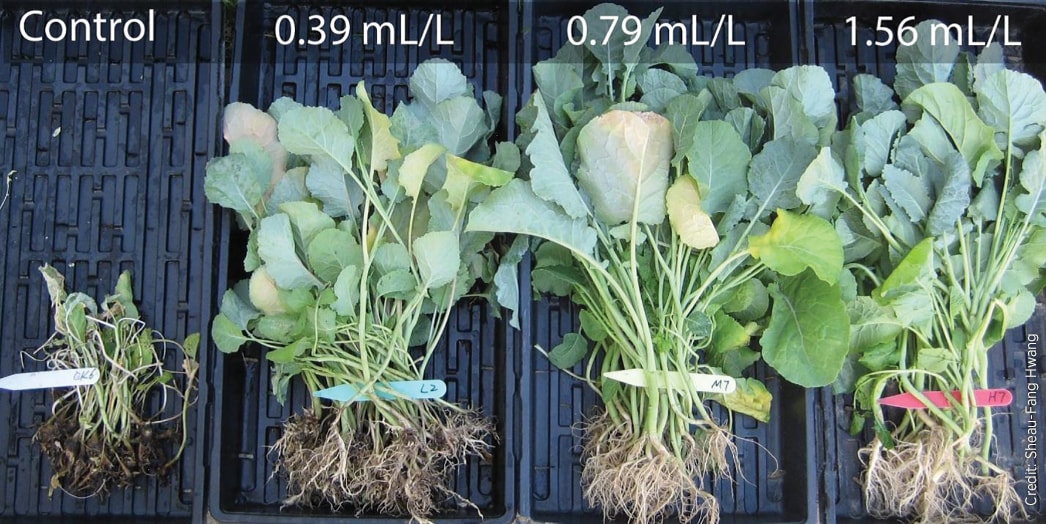Fumigant may be practical treatment for small clubroot patches
KEY RESULT:
Soil fumigation with metam sodium can reduce clubroot severity and improve plant health in the subsequent canola crop. But because of high rates required and high cost per acre, fumigation may have a role in the eradication of localized or isolated areas of infestation.
PROJECT TITLE, PRINCIPAL INVESTIGATOR:
“Toward a Strategy for Reducing the Spore Density and Dissemination of Clubroot of Canola in Alberta,” Sheau-Fang Hwang, University of Alberta
FUNDING:
Alberta Canola, ACIDF, WGRF
Clubroot continues to spread through Alberta and the Prairie provinces. In Alberta, clubroot occurrence expanded from 1,064 fields in 24 counties at the beginning of the project in 2014 to more than 3,000 fields in 40 counties by 2018. Preventing the establishment of clubroot in a field can save producers millions of dollars both in control measures and in lost crop revenue and land value. Fumigation at field entrances reduces spore populations in newly-introduced infestations and reduces the risk of more widespread clubroot establishment in a field.
The aim of this three-year project was to develop a better understanding of the distribution and dispersal of clubroot and to develop methods to eradicate or reduce newly established infestations within fields and on a regional basis. The research continued clubroot surveillance and added pathotype monitoring, which will allow for better risk assessment and the selection of appropriate management strategies.
Experiments were conducted to evaluate the effect of metam sodium (Vapam) fumigant and application methods including watering, soil surface covering and soil incorporation on clubroot of canola.
Application of metam sodium reduced clubroot severity and increased stand establishment, plant growth and yield. Vapam application was effective at 400-800 litres per hectare, with some residual toxicity noted at higher rates. (This is equivalent to the 40 to 80 millilitres per square metre in the photo.) The application was most effective and resulted in the highest yields when the treated area was sealed under plastic for 12 days, but sufficient ventilation time (one to two weeks) must be allowed afterwards before seeding to avoid residual toxicity. Researchers also assessed the biofumigant MustGro at several rates, but few treatment effects were observed.
Soil fumigation methods give producers the option to eliminate new clubroot infection sites before they become firmly established, thereby slowing the spread of the disease and minimizing its impact. Fumigation treatments may not be feasible or economical on a whole-field scale, but may be effective when targeted to localized spots in a field. Use of resistant cultivars will further reduce the risk of establishment of clubroot in a field. However, repeated cultivation of resistant cultivars in fields with established infections increases the risk of the development of new strains of clubroot that can defeat resistance resources.

Hwang, S.F., H.U. Ahmed, S.E. Strelkov, Q. Zhou, B.D. Gossen, G. Peng, G.D. Turnbull. 2018. Effects of rate and application method on the efficacy of metam sodium to reduce clubroot (Plasmodiophora brassicae) of canola. European Journal of Plant Pathology doi.org/10.1007/s10658-017-1281-y
Hwang, S.F., H.U. Ahmed, Q. Zhou, S.E. Strelkov, B.D. Gossen, G. Peng and G.D. Turnbull. 2014. Efficacy of Vapam fumigant against clubroot (Plasmodiophora brassicae) of canola. Plant Pathology 63: 1374-1383. http://Doi: 10.1111/ppa.12207
Hwang, S.F., H.U. Ahmed, S.E. Strelkov, Q. Zhou, B.D. Gossen, M.R. McDonald, G. Peng, and G.D. Turnbull. 2018. Suppression of clubroot by dazomet fumigant. Can. J. Plant Sci. 98: 1-11. https://doi.org/101139/CJPS-2017-0099





